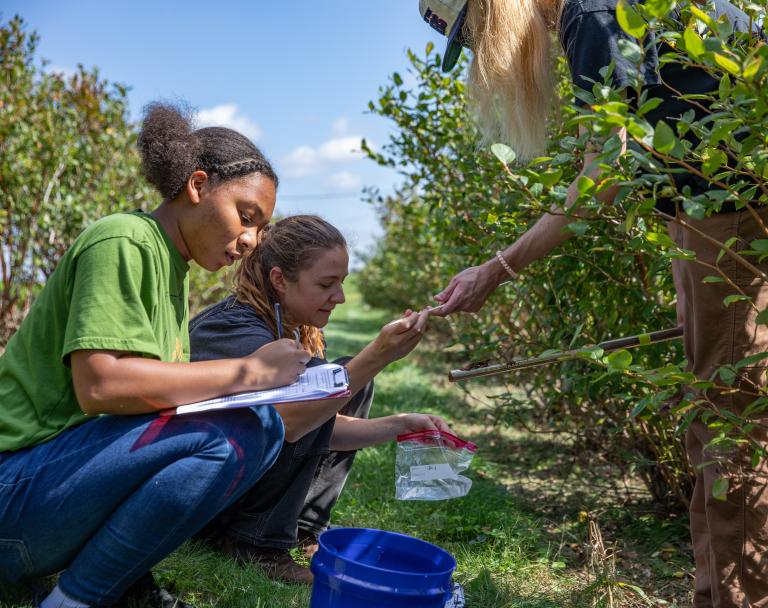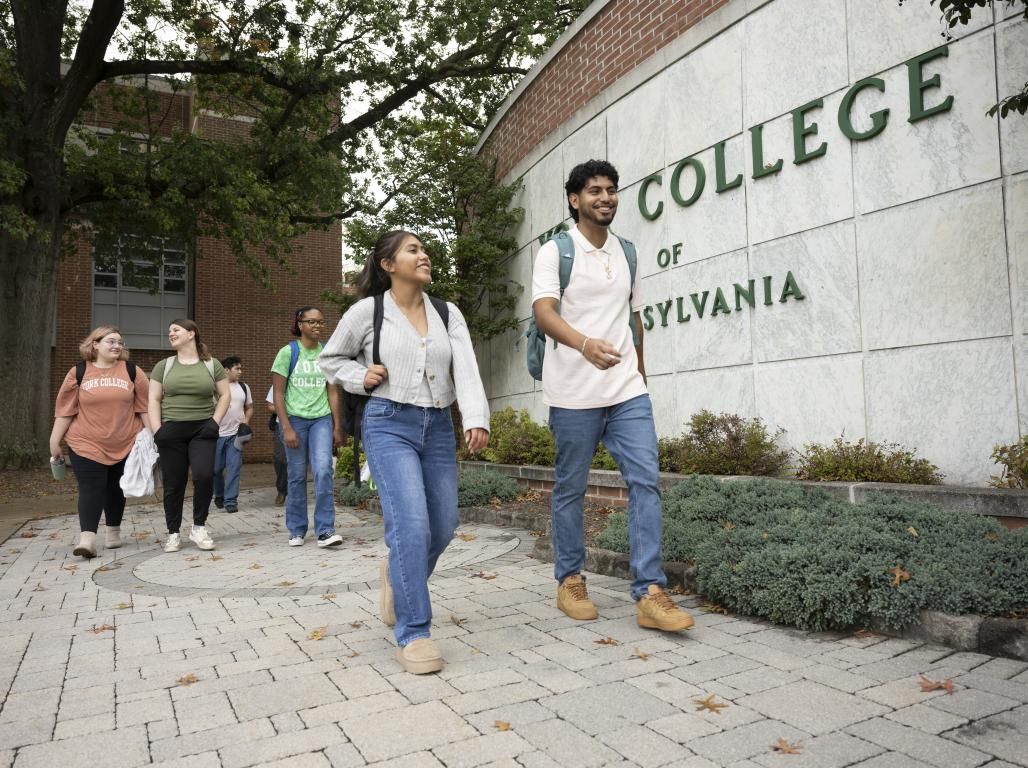Thanks to drone technology, Dr. Stephen “Drew” Wilkerson of the Mechanical Engineering Department and Dr. Jason Smith of the Environmental Horticulture Department are exploring how a Maryland orchard’s soil may be affecting the health of its plants.
What started as a drone study on light and how plants use it to reflect their health has evolved into an unexpected collaboration between the Mechanical Engineering and Environmental Horticulture Departments.
Shaw Orchards has been home to the Shaw family and a plethora of fresh fruits, vegetables, and other goods since 1841. Seven generations of Shaws have owned and cared for the land in that time, each finding ways to expand the farm and grow it into the thriving business it is today.
While the orchard is known for its produce, students and faculty at York College of Pennsylvania have been drawn to the area for a different reason; its soil.
The reason for the sudden interest? Drones.
Due to his acquaintanceship with the orchard’s current owner, Barron Shaw, Stephen “Drew” Wilkerson, Ph.D., P.E., Associate Professor of Mechanical Engineering at York College, regularly comes to test his drones and their ability to monitor plant development and health. Using their spectral cameras, the drones take hundreds of pictures of the light reflected off plants while completing a pre-programed route. Later, the images are stitched together into one photograph containing all of the data about every plant encountered.
Using the data, Dr. Wilkerson gained a vast amount of information about the plants, specifically on how the light can be a reflection of the plant’s health status, such as if they are stressed or not.
During one of his more recent visits, Dr. Wilkerson’s pictures revealed that based on the light signatures gathered, the plants were exhibiting signs of stress, an indicator of something negatively affecting their health. What really piqued his interest, though, were the physical signs of plant stress appearing only days after recovering the photographs.
Dr. Wilkerson’s curiosity on what this could mean led him to extend an invitation to Jason Smith, Ph.D., Assistant Professor of Environmental Horticulture at York College, to see if he could find any correlation between the quality of the plants’ soil and their stress. After all, the soil the plants were exposed to appeared to be the one constant factor that could be tested and have a strong impact on the vegetation there.
“It’s kind of this overlooked topic,” Dr. Smith said, “because to all of us, dirt is dirt, until you really start to recognize that not all dirt is created equal and the way that we treat it is going to have a huge impact on how well it supports plants. So a lot of plant health and productivity is a direct reflection of the quality of the conditions of the soil.”
Ultimately, Dr. Smith thought it was a fantastic idea, and decided to bring his Horticulture 320: Soil Science and Fertility class to collect samples.
Sharing Knowledge
As the travel day drew closer, Dr. Smith and his environmental horticulture students created a game plan on how they were going to conduct their research.
They decided to focus on taking samples from two blueberry fields in the orchard where some of the plants were visibly more stressed than the others. Barron Shaw wanted to know if these differences might be due to variation in soil pH, which is a feature of soil that affects the release of nutrients to plants.
Dr. Wilkerson even brought some of his own senior mechanical engineering students into Dr. Smith’s class prior to the excursion to explain how the drones functioned and collected data for the students to reference. Seeing how well the students got along and were already working together to conduct research made Dr. Smith excited to see the impact drone technology was having on solving environmental issues.
“If we have a lot of variation in pH,” Dr. Smith said, “and [Dr. Wilkerson’s] seeing a lot of variation in the spectral qualities that the drone’s cameras can view, then we can look mathematically and see if there’s a correlation between those two, which would be a nice step forward in making good use of the drone’s capabilities.”
Sampling Soil
When the actual day came to visit the orchard, Dr. Wilkerson’s students arrived earlier in the day and used their drones to take up-to-date photographs of the orchard fields. Dr. Smith’s students arrived later and collected soil samples from the two blueberry fields.
Once the soil samples were brought back to their labs in the Environmental Horticulture Center and turned into a slurry, tests were conducted to see if there were any oddities that stuck out when compared to samples collected from elsewhere. One assessment involved exposing the samples to simulated rain to explore their resistance to the elements. If the students found the soil melting away, it would indicate that they are more prone to erosion.
The data are important for farmers to be aware of, especially if they find that the conditions are the result of how they treat their soil. Factors such as how often the dirt is tilled or sprayed with herbicides can cause the breakdown of tiny, hard-to-see soil crumbs known as aggregates. Without this ‘natural glue’ to help bind together the smaller soil particles, they will wash out in the rain and be vulnerable to natural elements in general.
“There’s a lot of on-the-ground experiment work that needs to be done because a plant can look stressed for any number of reasons,” Dr. Smith said. “It can be a nutrition problem, a watering problem, a disease problem, an insect problem, it can be a temperature problem. It really takes a horticulturalist’s eye to start to tease out what are the issues on the ground that could lead to the plant performing poorly.”
Future Collaboration
As the students continued to study the samples, Dr. Smith expressed how much of a fantastic experience the collaboration between the two departments was. He felt that the students learned a lot from the hands-on excursion, and that making the trip to Shaw Orchards provided a wonderful learning opportunity.
“I could see this happening again,” Dr. Smith said. “I’m often looking for community partners for my class because I think what we do has to be directly relevant to what growers are doing. If the things we’re learning connect to things we find on farms, that’s a huge validation of the relevance to what we’re learning.”
Already, Dr. Smith is considering other ways for his future environmental horticulture students to continue connecting with the Mechanical Engineering Department. One such idea involves a class he plans to teach in the Spring Semester, Greenhouse and Nursery Production, and having his students build a controller for irrigation. He will be talking to the Mechanical Engineering Department to see if it would be a good collaboration project between the students.
Even though the area of mechanical engineering isn’t his specialty, Dr. Smith acknowledges that the impact of their work with technology can lead to profound breakthroughs and assistance in solving problems in the environmental world. Like with drones, even though some people may have their doubts about their effectiveness and necessity, using them to alert farmers or other growers when the health of their plants begins to decline can make a world of a difference.
“Where the industry would like to go,” Dr. Smith said, “is…to have such a clear understanding of environmental factors that affect the color signatures in plants that drones can record that when you send a drone out, you have a short list of possible explanations for the colors you’re seeing rather than a really long list.”

Gaining Experience from the Ground Level
See how York College students put their education to work at Shaw Orchards.





